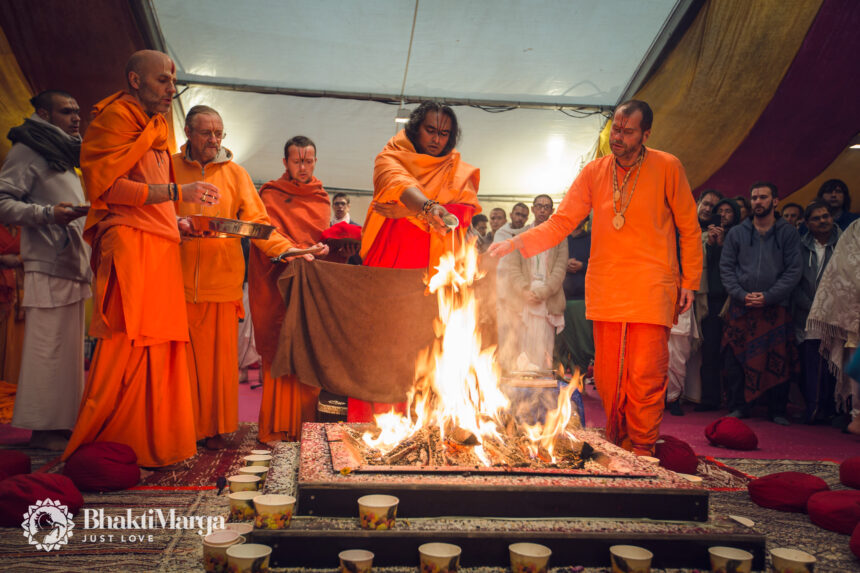Vedic Defense Through Rigveda Richas: A Deeper Look at Divine Protection
Part VIII – Hymns of Safeguard
Learning the Principles of Vedic Defense
The Vedic Defense Blog is dedicated to exploring how ancient Hindu scriptures offer a civilizational shield. The Rigveda is far more than ancient poetry; it is a profound living text that encodes a divine response to human challenges, both material and spiritual. In a world facing increasing threats from those who do not subscribe to Scientific aspects of Hinduism, returning to these foundational hymns is not an act of ritualism but of restoration. This blog, a continuation of our Vedic Defense Blog series, delves into select hymns from Rigveda Mandala 1 that are direct, purposeful, and aligned with the spiritual strategy of the seers: invoking divine strength to defend truth and repel external forces that threaten dharma while adhering to the principle of nonviolence.
These verses remind us that Vedic knowledge is not passive; it is protective. The protection sought is not a classical, internal psychological one, but a decisive external defense. These hymns explicitly request divine intervention against forces of adharma—whether they manifest as powerful enemies, deceptive foes, or those who obstruct the path of the righteous.
Why we need Vedic Defense
The Vedic Defense Blog explores how the Rigveda provides a shield against external threats. This blog, part of our ongoing series, selects hymns that directly invoke divine strength to repel forces that threaten dharma. This understanding of defense is rooted in the proven wisdom of yagna and the transformative effects of regular chanting. We believe these ancient practices offer a decisive external defense, not just an internal, psychological one.
Agni: The Axis of Sacrificial Power
In our Vedic Defense series, we have established Agni’s role as a purifier and a “firewall that guards yagñas from corruption” – the divine force who protects sacred rituals from external interference and empowers righteous action.” In these hymns, Agni’s protective power extends into the physical realm, offering a clear and tangible shield. He is the divine force that empowers the righteous.
Rigveda 1.31.6 – Original Sanskrit
त्वमग्ने वृजिनवर्तनिं नरं सक्मन्पिपर्षि विदथे विचर्षणे.
यः शूरसाता परितक्म्ये धने दभ्रेभिश्चित्समृता हंसि भूयसः..
Translation: “O Agni, who possesses specific knowledge! You guide a man of misconduct towards salvation. When a great war begins, by your grace, a small number of brave men kill many great heroes.”
This verse clearly outlines Agni’s dual role: spiritual guide and battlefield supporter. It is a direct statement that Agni’s power manifests in physical conflict, empowering a few to defeat many. This is a prayer for divine military assistance.
Rigveda 1.31.12 – Original Sanskrit
त्वं नो अग्ने तव देव पायुभिर्मघोनो रक्ष तन्वश्च वन्द्य.
त्राता तोकस्य तनये गवामस्यनिमेषं रक्षमाणस्तव व्रते..
Translation: “O venerable Agni! By your protective power, protect the bodies of us who are wealthy and our children. Our grandchildren are always engaged in your sacrifice. You protect their cows without blinking.”
This hymn is a plea for comprehensive physical protection—of our bodies, our families, and our property. It portrays Agni as a sleepless guardian, a constant shield against any threat.
Indra: The Destroyer of Malice
The blog’s core theme of “hard protection” is most potently embodied by Indra, the destroyer of obstacles and vanquisher of foes. Sukta 32 is a classic example of this. This section of the Vedic Defense Blog explores his decisive act of destruction against the demon Vritra, a timeless allegory for the forces of chaos and obstruction. This is not a subtle battle; it is an act of decisive destruction.
Rigveda 1.32.5 – Original Sanskrit
अहन्वृत्रं वृत्रतरं व्यंसमिन्द्रो वज्रेण महता वधेन.
स्कन्धांसीव कुलिशेना विवृक्णाऽहिः शयत उपपृक्पृथिव्याः..
Translation: “Indra killed the enemy who spreads darkness with his great, destructive thunderbolt, cutting off his arms. Vritra lay on the earth, just as a tree branch cut by an axe falls.”
This verse is a prime example of the martial tone of these hymns. It describes a violent, final act of destruction by Indra. The enemy is not reasoned with or converted; he is annihilated so that order can be restored.
Rigveda 1.32.11 – Original Sanskrit
दासपत्नीरहिगोपा अतिष्ठन्निरुद्धा आपः पणिनेव गावः.
अपां बिलमपिहितं यदासीद् वृत्रं जघन्वाँ अप तद्ववार..
Translation: “Just as the demon Pani had locked the cows in a cave, so too were the waters, protected by the demon Vritra, restrained. Indra, by killing Vritra, opened that door.”
Here, the destruction of the enemy directly leads to the restoration of natural, life-giving flow. It is a powerful metaphor for how eliminating a threat brings freedom and prosperity.
Indra: Forces of Storm and Victory
These hymns continue with Indra’s decisive action against those who defy the righteous. They reinforce the idea that Indra is an active, militant force that defends his devotees against all external threats, whether physical or ideological.
Rigveda 1.33.4 – Original Sanskrit
वधीर्हि दस्युं धनिनं घनेनँ एकश्चरन्नुपशाकेभिरिन्द्र.
धनोरधि विषुणक्ते व्यायन्नयज्वानः सनका प्रेतिमीयुः..
Translation: “O Indra! Though the mighty Maruts were with you, you alone killed the wealthy thief Vritra with your hard thunderbolt. His followers who opposed the sacrifice went with the thought of killing you, but they met their death by your bow.”
This hymn again portrays Indra as a solitary, unstoppable force. He not only destroys the main enemy but also his entire entourage of followers. This is a complete and decisive victory.
Rigveda 1.33.7 – Original Sanskrit
त्वमेतानुदतो जक्षतश्चायोधयो रजस इन्द्र पारे.
अवादहो दिव आ दस्युमुच्चा प्र सुन्वतः स्तुवतः शंसमावः..
Translation: “O Indra! Some of Vritra’s followers were making fun of you, and some were crying out of fear. You fought them all in the sky and brought the demon Vritra from heaven and destroyed him with his family. In this way, you protected those who prepared the Soma and those who sang hymns.”
This verse is a clear and potent message: Indra defends those who honor him. He not only fights the enemy but also protects his devotees from physical harm.
Reflections on Vedic Defense Through Rigveda Richas
These mantras are not echoes of a forgotten past—they are living weapons of clarity. They do not encourage humans to retaliate, but they absolutely refuse surrender. They are a core part of a Vedic strategy for survival that sees invoking the Devas as the ultimate way to shield the righteous, destroy adharma, and maintain cosmic order (ṛta).
This is the purpose of the Vedic Defense Blog: to empower you with knowledge of these ancient, powerful verses. Invoke, don’t retaliate. But never stand defenseless. Let the Rigveda protect you, as it did the yajamānas of old.
Call for Action
🛡️ Practice daily, with purpose. 🕉️ Understand before you invoke. Let the Rigveda not be merely heard — let it protect.
Learn how to chant
Save the audio chanting file for regular play and listening
Watch the Video in Hindi or English.
Watch and save the Video or Audio for daily listening.
Feature Image: Click here to view the image.
Watch Related Videos
Download this video and practice it daily
With Hindi Commentary
With English Commentary
Download this video clip to listen as often as possible with Hindi commentary
Glossary of Terms
- Adharma: Forces or actions that oppose dharma; unrighteousness, chaos, or anything that disrupts cosmic and moral order.
- Agni: The Vedic fire deity who serves as the divine messenger, purifier, and protector of sacrificial rituals; central figure in Vedic worship and defense.
- Devas: Divine beings or gods in Hindu cosmology who represent various cosmic forces and are invoked for protection and blessings.
- Dharma: The cosmic principle of righteousness, natural law, and moral order that governs both individual conduct and universal harmony.
- Indra: The king of gods in Vedic tradition, wielder of the thunderbolt (vajra), and destroyer of demons and obstacles to cosmic order.
- Mandala: A division or book of the Rigveda; the text is organized into ten mandalas, with Mandala 1 being referenced in this blog.
- Pani: A demon or evil spirit in Vedic mythology who stole cattle and hid them in caves, representing forces that hoard resources and obstruct prosperity.
- Richas: Individual verses or hymns from the Rigveda; the fundamental units of Vedic sacred poetry containing mantras for various purposes.
- Rigveda: The oldest and most sacred of the four Vedas, containing over 1,000 hymns composed in Sanskrit and forming the foundation of Hindu spiritual practice.
- Ṛta (Rita): The cosmic principle of natural order and truth that governs the universe; the divine law that maintains harmony in both spiritual and physical realms.
- Sukta: A hymn or collection of verses in the Vedas dedicated to a particular deity or theme; literally means “well-spoken.”
- Vajra: Indra’s divine weapon, the thunderbolt or diamond-hard club used to destroy demons and clear obstacles; symbol of indestructible spiritual power.
- Vritra: The great serpent demon or dragon of drought in Vedic mythology, representing chaos, obstruction, and the withholding of life-giving waters.
- Yajna (Yajña): Vedic fire sacrifice or ritual offering that maintains cosmic order and invokes divine protection; central practice in Vedic tradition.
- Yajamānas: Those who perform or sponsor Vedic sacrifices; the practitioners who conduct yajnas and invoke divine protection through proper ritual.
#VedicDefense #Rigveda #HinduinfoPedia #Agni #Indra
#HymnsofSafeguard
Previous Blogs of the Series
- https://hinduinfopedia.org/civilization-under-siege-why-hindu-communities-face-an-existential-crisis/
- https://hinduinfopedia.org/crisis-documented-mathematical-evidence-of-systematic-hindu-elimination/
- https://hinduinfopedia.org/vedic-defense-mantras-rigvedas-protection-against-threats/
- https://hinduinfopedia.org/agni-suktas-for-protection-invoking-divine-fire-against-adharmic-forces/
- https://hinduinfopedia.org/indra-suktas-for-victory-invoking-the-divine-warrior-against-overwhelming-odds/
- https://hinduinfopedia.org/ashvini-kumar-suktas-for-divine-rescue-and-healing/
- https://hinduinfopedia.org/ashvini-kumar-suktas-for-divine-rescue-and-healing/



Leave a Reply